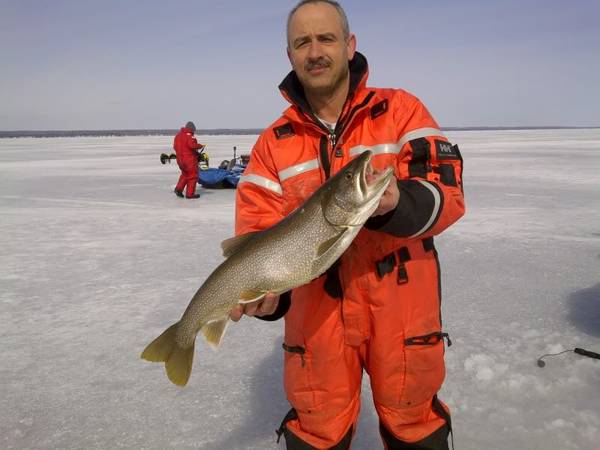-
Posts
6,934 -
Joined
-
Last visited
-
Days Won
38
Content Type
Events
Profiles
Forums
Store
Posts posted by aplumma
-
-
O.K. back to plastics or a winternet lock will be applied.
Art
-
Very nice thanks for the article.
Art
-
Nice setup Mike it should be fine no matter what the weather is.
Art
-
Seems to me, you may want to stay away from metal screw/bolts that will will react in contact with alluminum.
What does this mean for aluminum?
Galvanic corrosion is the most common cause of
aluminum corrosion due to its inherent resistance to
more natural forms of corrosion and a lack of
preventative measures taken.
INFO LINK (PAGE 4): http://cmiengineer.com/whitepapers/aluminum_corrosion.pdf
You are correct however the part of the formula missing is a median for the metals electrons to migrate is for the most part missing. You need a fluid to allow the electrolysis to occur. The boat in question likely lives on a trailer and since aluminum oxidizes rapidly it has the desired ability to seal itself. The use of Zinc and or Magnesium are used extensively to stop electrolysis in boats that are left in the water. I have a 28ft aluminum boat with stainless steel and brass shafts and screws that lives in brackish water and with the use of a galvanic isolator and zinc's it has survived since 1985 till today with no damage.
Art
-
Don't be afraid of the additional information it has it's uses. I sometimes find the unit can mean the difference between a good trip and a great trip. You got to think of it as a tool you don't still fish with a zebco 202 you upgraded to a reel that made fishing more productive and easier to reel in the fish. Same thought pattern for a good depthfinder. You will find the more information on the environment you are catching fish on a particular day the easier it becomes to find the pattern of the fish. I have found on some days the pattern is to find freshwater mussels were the big cats feed and other days it is an area of wood in the middle of nowhere to be the answer. Both are difficult to find using conventional sonar but the downscan tuned correctly makes them easy to find. You also with a good sonar will be able to find the thermocline the key to fishing lakes effectively. I have spent many a day with a long pole tuning the COLOR depthfinder and then poking the bottom to feel what it is made of. I even have gone so far as to lower dead fish of different sizes below the boat to see what they look like on the screen. After doing this you can accurately tune the unit to show the differences between large and small fish. The ability of the more expensive units to hand tune out the clutter and false signals is worth the money in my book. Keep looking and reading all you can then you will have the time to get the unit you want and not just settle for the unit you can afford at this time. The key to being able to catch fish is the ability to collect and understand the clues mother nature gives you and anything that makes that information available to you is worth the time and effort to learn.
Art
-
The higher the frequency the more detail is presented. The difference is actually due to how the signal is processed. The 83/200 is sent out and processed as a cone that is wider as the distance increases from the transducer. The 455/800 is sent out as a narrow cone but processed as a sheet. Both do an excellent job of spotting fish and by learning your unit and getting past the auto settings you can get more information from the unit than some can get from a camera. I am running a HDS7 with the LSS 1 unit and can set it to read the 83/200 overlay ed on the 455/800 and then on one or two separate screens with any two of the 4 frequencies next to it. You will find with time on the water that their are times that the 83 will show a fish while the 200 misses it and vice versa. If you want to get the HDS series as a starting point then go back for the LSS1 unit you will be very happy with the end result. The big advantage will be you will learn what the 83/200 has to offer you before you have to learn how to process the amazing amount of information the LSS1 unit gives you.
Art
-
On my aluminum boat I drilled out the hole and put a tank to bowl toilet bolt in. The bolthead is outside then the rubber washer then boat then rubber washer then flat washer and finally the nut with a locking back up nut. No leaking in 12 years plus.
Art
-
In Virginia you have some great choices. Right now The lower Potomac is one of our premier areas for largemouth bass. There is an area called Pohick Bay located in an area called Lorton Virginia. The time for spring fishing is around Mid March if you want to get into some of the best fishing time of the year. If you have all of the item required for Canadian Boating they will be fine for this area. You can purchase your license on line or at any local Wal Mart in the area. If you decide to come to the area send me a P.M. and I will go indepth as to areas that you can fish within a 1/2 hour of the launch point. You also can fish for Perch, Snake heads, Stripers and the big Blue Catfish. The Stripers will be hit or miss on the big ones but the yearlings are here all year around. The average Pike combo will be fine for what you fish for and the muskie combos are for the Blue Catfish. Depending on timing I might be able to hook up with you or have one of my buddies take you out for the day. Pohick is a park and has a nice launch and their are golf courses at the same location. The area has hotels that are close and range from the mom and pop to national chains. This area is located 1 hours from Washington if you want to see the sights and has a wealth of Civil War sites to entertain you.
Art
-
you can rebuild the flowrite valves cost is about 20 bux for both valves rubber flappers, you can also buy the new valves for 30 bux each.
i put the rule pumps in ss well, takes up a little more space in the bilge but they have replace main pump bodys so when they do burn out it's a quick change, they also have a extra port so you can attach a wash pump if desired, (my next project) good to quickly flush the cooling system on an engine when i suck up more lily pads and crap or cleaning livewells
I did the same thing and adjusted the hoses for more room to mount my transducer on a 1989 Ranger.
Art
-
Here is the place for all of the info you will ever need. Brought to you by our fearless leader T.J.
Art
-
The unit is from the late 70's and is a flasher type unit. Currently it is listed as a vintage flasher for less than 30 dollars on assorted websites. Specifications on the unit were not found. I would wire it to 12 volts and see if it lights up and runs. If it doesn't then plug it in to the wall and see if it lets out the factory smoke if it does you are out $30.00. I am betting it is a 12 volt unit.
Art
-
color color color.... Dan the information that you can read off the color units is years ahead of the B&W units. I use the lowrance with LSS1 and it is far and above any other unit I have used in the past.
Art
-
I have but it was not long before it was trashed. Save up a little more for a better series of reel.
Art
-
I have the core and it is on a custom rod to keep the weight down. I can cast all day with the set up and not have any issues with forearms getting pumped. If you are putting it on a heavy unbalanced rod then save your money and accept a heavier setup.
Art
-
"Motion" (Antonio Mazzuca)
Age:
51 years old
Born
October 8, 1960
Departed
February 11, 2012

Location:
Vaughan/Lagoon City
Interests:
Fishing, Camping, Hockey
"God called Antonio on Saturday, February 11, 2012 at the age of 51. He will be held dear in the hearts of his family, relatives, and many friends."
-
The prop is out of balance it does not take much. Replace the prop and it should go away if the bearings are not damaged already.
Art
-
if anyone is going to the US border towns, could you stop and pickup a box full of crack cocaine lures for me at my US mail address and bring it across for me..thanks...LOL
I learned my lesson the hard way. I once offered to forward a package for someone who was a casual friend up North. For some reason he never got his Switchblade knife he ordered.
 :wallbash:
:wallbash: 
Art
-
I agree with the spring time it will make it cheaper for sure. If you have a clean out cap outside of the house you can stick a tape measure down it to the bottom and get an idea of how deep the line is. Then measure out from the house and for every 4 feet the pipe will drop one inch. That means 8ft down at the house and 40ft from the house the line is 40 divided by 4 = 10 inches. The pipe is 8ft 10 inches deep at that point. Their are reasons that this could be incorrect it depends were they jumped down for the lateral but usually they try to do that within the last 10ft before the street. If their is no clean out were the pipe goes below the basement floor add 20inches from the slab to the dirt line outside of were it leaves the house and apply the 1/4 inch per foot rule.
Art
-
I will chime in even though others have covered the issue. The tree even after it is cut will continue to be an issue for 3-5 years even though it has no greenery above ground. The roots are as thin as a human hair when they got thru and they continue to grow in size and fracture the pipe. The elimination of the roots after they rot out is still a pipe that is full of holes and debris will wash in. Their are no chemicals that will solve this problem the copper tox and other will slow down the root growth but will not clear them out of the pipe. The best way is to have the old line replaced from the house to the service tap were they connected to the stub out the county provided when the land was subdivided. The use of ABS or PVC pipe is a big advantage due to the fact the joints are solvent welded and unless damaged roots will not be able to get into the system again. Discuss this with your insurance company some polices will pay for the digging of the line and the reinstallation of the ground but not the actual replacement. They also might have it worded they will not replace the line but will fix the line instead. Getting the insurance company involved does have the danger of them denying any future claims for water damage once it is brought to light you have roots in the system.
Art
-
I'M lost on this one and I can't see an upside to it.
Art
-
Nice catch that things a tank.
Art
-
-
That sounds like you got a great start on getting your baby redone. Cool Deal.

Art
-
Drip dry is your issue bud. Water spots are nothing more than minerals, dirt and soap that is left behind as the water evaporates. The secret is either wipe it down or use products that reduce surface tension. I use Rain X on the glass and just a quick wipe down is all it needs. Using a good wax or soaps that have anti spotting compounds in them will save you time on the dry up.
Art



Pier Fishing
in General Discussion
Posted
You know all of these good reports lead to pier pressure right.....
Art